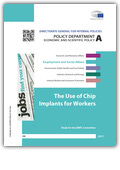The EU wants to TAG its citizens like CATTLE AND CAN START MAY 2023

Nov 22, 2023
I am reprinting this because I believe the chips will be revisited when the WHO has the ability to set aside Human Rights concerns in the event of their emergency declaration. As such the Treaty and the IHR regulations will change life for all of us. (left and right alike- please understand that we need to unite past the ideological differences).
The EU has been studying mandatory chip implants since 2017 and has an in depth published study examining the technology and the barriers needed to overcome in order to chip their population.

The publication is titled:
DIRECTORATE GENERAL FOR INTERNAL POLICIES POLICY DEPARTMENT A: ECONOMIC AND SCIENTIFIC POLICY The Use of Chip Implants for Workers
The Abstract of the Study reads
Abstract This paper briefly explains the technology of RFID chip implants; explores current applications; and considers legal, ethical, health, and security issues relating to their potential use in the workplace.
WHO PREPARED IT
“This document was prepared by Milieu/IOM Ltd at the request of the Committee on Employment and Social Affairs of the European Parliament”
WHO WANTED IT
“This document was requested by the European Parliament’s Committee on Employment and Social Affairs (EMPL).
WHO AUTHORED IT
“AUTHOR(S) Richard GRAVELING, IOM Consulting Ltd, Edinburgh, UK. Thomas WINSKI, IOM Consulting Ltd, Edinburgh, UK. Ken DIXON, IOM Consulting Ltd Contributions by: David CABRELLI, School of Law, University of Edinburgh, Edinburgh (legal) Marc DESMULLIEZ, School of Engineering and Physical Sciences, Heriot Watt University, Edinburgh (technical) Murdo MACDONALD, Society, Religion and Technology Project, Church of Scotland, Edinburgh (ethical) Peer review: Hilary Cowie, IOM Consulting Ltd, Edinburgh, UK. Joanne Crawford, IOM Consulting Ltd, Edinburgh, UK. Claire Dupont, Milieu Ltd, Brussels RESPONSIBLE ADMINISTRATOR Stefan SCHULZ EDITORIAL ASSISTANT”

LEGAL ISSUES IDENTIFIED
“Legal Issues Although other legislation is relevant, the main legal challenges to the compulsory use of RFID chips in the workplace would seem to derive from data protection and human rights legislation. “
“Even where RFID chip use was truly voluntary this legislation would still be relevant, especially in respect of data protection. In the case of voluntary applications, it would be necessary to ensure that the use was genuinely voluntary and that no disadvantage was seen to accrue to those individuals who declined to have a chip implanted or that any pressures (direct or indirect) were exerted on those invited to participate. “
“Ethical Concerns In an overlap with legal arguments, ethical concerns stem in part from Articles 1 and 3 of the Charter of Fundamental Rights of the EU relating to the inviolability of human dignity and the human body.”
WHO IHS AMENDMENTS
The benefit for globalists who are clearly bent on micro control of its citizens, are the WHO IHS amendments and/or Pandemic Treaty. The IHHC met in January to formalize changes to the WHO regulations and these could be approved by May 2023..
These amendments WILL permit the suspension of Articles 1 and 3 of the Charter of Fundamental Rights of the EU. Thereby overcoming the legal and ethical considerations that mandatory chipping of EU residents would otherwise have as barriers to this horrible unethical immoral network-branding its citizens. No doubt the chipping will work with the vaccine passport they intend to roll out. I posted this video on another substack. But I am seriously hopping this gets shared to Europeans who are not yet my readers.
Tony Blair’s remarks at Davos are pure evil.
ETHICAL ISSUES
“Further ethical issues relate to health and safety concerns; the efficacy of Policy Department A: Economic and Scientific Policy 8 PE 614.209 the technology as a secure system; equity and choice; and (again in a parallel with legal issues) religious concerns.”
HEALTH CONCERNS
The study itself identifies expressed health and safety concerns.
“Health and Safety Worries Concerns have been expressed over the health and safety of RFID chip implants in four main areas: carcinogenicity; migration; interactions with MRI signals and the impact on pharmaceutical effectiveness. There have been no systematic studies of health impacts in human wearers. There are a number of reports of carcinogenic effects, mainly in specific strains of mice. However, it appears that this probably reflects the unique sensitivity of these species and is not a trans-species phenomenon. Potential mechanisms suggest any similar effects in humans to be unlikely (although currently impossible to discount completely with the present state of knowledge). Studies of the potential interactions between MRI scanning and chip implants appear to have excluded any significant effects, although local details on a scan can be physically masked by the chip overlying the area of interest.”
Don’t worry we’ll stick your chip someplace else
“This problem can easily be overcome by inserting the chips into areas of the body where scans are not likely to be required. It is suggested that inter-species differences in the characteristics of sub-dermal layers makes significant migration unlikely, although this cannot be categorically excluded.”
Where’s the best place to Chip Europeans?
“Early reports of implanted chips suggested the upper arm as an injection site, although more recent applications seem to favour the web of skin between the thumb and first finger (usually of the left hand in right-hand dominant individuals). This has the benefit of being relatively unobtrusive as well as perhaps less likely to encounter significant migration due to anatomical constraints compared to the upper arm.”
RFID TAGS in Pharmaceuticals circulating
The study names a side effect that may come from the confusion RFID tags in the Pharmaceutical products that the European citizen took if I read this correctly.
“Concerns regarding the impact of RFID technology on the efficacy of pharmaceuticals appear to stem from the proposed use of RFID tags as a security measure to label containers of pharmaceuticals. This would therefore involve scanning of the bulk compound. Any risk of an effect in vivo in scanning the compound circulating within the blood stream when briefly scanning for an RFID chip would be extremely limited as only a small proportion of the substance would be exposed during scanning.”
Security Problems
The writers seemed concerned that someone could bypass their chip system through cloning, disabling, tag modification, and eavesdropping… ON EUROPEANS BODIES.
“Possible Security Problems It would seem that, at present, the RFID chip technology (which is essentially similar to that used in credit cards and similar smart card systems) is not entirely secure. Security concerns include eavesdropping; cloning; disabling; and unauthorised tag modification. Although since their initial development there have been a number of schemes promoted to increase their security, usually with some form of encryption, it seems from the literature that each idea is swiftly followed by other researchers reporting some way of breaching the security measure proposed.”
PASSIVE OR ACTIVE. DO WE NEED TO PLUG IN EUROPEANS SO THEIR CHIP CAN READ/WRITE?
“Implantable RFID chips can be passive – designed to be ‘read only’ – or active, where data can be stored on the chip and the device has a ‘read-write’ capability. Although chips are also available that transmit a signal (allowing them to be used for tracking applications) the power requirements for such devices mean that they need to be a larger size (to contain a battery capable of storing and providing the necessary power) or need to be connected to a separate power source. Both of these factors mitigate against their ready use as implanted devices. Only the passive devices are considered in this paper, although many of the considerations concerning their use will also apply to active devices”
HOW COMFORTABLE ARE THESE CHIPS
“The chip consists of three parts: an integrated circuit, a means of acquiring power from the reader, and an antenna for receiving signals from and transmitting signals to a reader.”
For human (and animal) use, these must be encapsulated within a biocompatible material (usually a form of glass). Non-implantable devices used for commercial applications or animal applications may be encapsulated in polymers that are unsuitable for human implantation. The chip material in contact with human tissue must not harm, inflame or change the composition of that tissue. Undesirable local or system effects in the human body must be avoided. Moreover, the chemical stability of the encapsulating packaging is essential, with good resistance to attacks from the harsh internal environment. Inside the human body, hydrolytic, oxidative and enzymatic mechanisms take place that can modify the chemical structure of polymers leading to biodegradation (Donaldson, 1976). Glasses and ceramics can withstand long periods of resistance to gas or fluid ingress (defined as permeability) ranging from months, or tens of years, depending on the material thickness.”
EUROPEANS TO BECOME ‘NETWORKED’ THROUGH THE CHIPS
“The RFID chips are used as part of a system that has four component parts: • The RFID chip (also known as a tag) stores information about the chipped person and sends this information back to the reader when a signal of the correct frequency is sent to the chip by the RFID reader for interrogation.”
“As it is a TRANSMITTER and a RESPONDER, RFID chips are classified as ‘transponders’. As noted above, there are two main categories of chip. The passive chip gets its electrical power from the electromagnetic waves emitted by the RFID reader.”
“The active chip has its own battery that tends to limit its useful life and add additional components to be contained within the device. Both types of chip have their own antenna (or coil).
“• The RFID reader is a device that broadcasts an electromagnetic signal that any RFID chip within range and operating on the same frequency will respond to. Drawing its power from this signal, the RFID chip will respond with an encrypted signal. The RFID reader will decode this and pass the resulting information to a network.
• The NETWORK gets the decrypted information from the reader and transmits it to a computer for processing. Sometimes, a simple interface between the computer and the reader is used instead of a network.
• The COMPUTER (also called the host or controller) controls the RFID reader with software controls. It processes the information received from the network to enable an operator to make a decision.”
Well while Oxford and London are battling the 15 minute city and all of Scottland is facing the 20 minute city they can perhaps have some small solace for Brexit.
However Europeans should share this information because it was labelled a conspiracy theory.
But it would appear that the European Union have every intention of going down this dark path. The barriers to the tagging like cattle of its citizens are within grasp if they pass the WHO IHS amendments.
The proper response to this information would be to demand that the original statutes in each country that invoked the original IHR treaty in 2005 be repealed forthwith, starting with Italy since it has a receptive Prime Minister in Meloni.
I would appreciate your support with a paid or free subscription and sharing of this article.
LawyerLisa’s Substack is a reader-supported publication. To receive new posts and support my work, consider becoming a free or paid subscriber.”
Leave a Reply